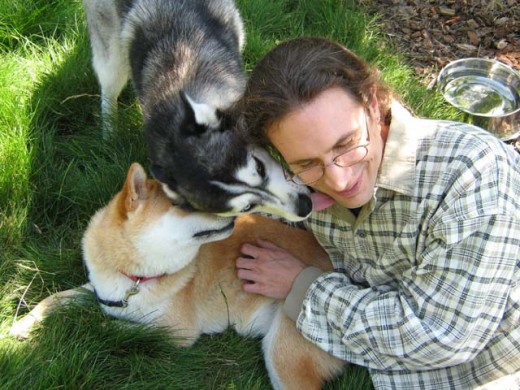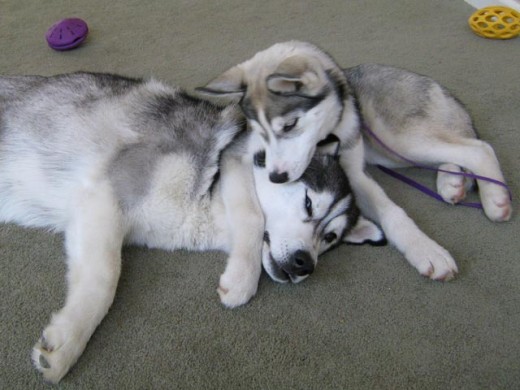We like hugging.
We hug in greeting, and we hug in parting. We hug to show love, support, happiness, and much more.
However, dogs do not have the same language for hugs that we do.
Dogs are built differently, and communicate in a different way.

Do Dogs Like Hugs?
According to experts (Turid Rugaas and Patricia McConnell), the closest thing a dog knows to a hug, is mounting or placing a paw on another dog’s neck and back. Both of these gestures can be used in play between familiar and trusted dog friends, but they can also be used for dominance, especially between unfamiliar dogs.
Therefore, when we try to hug a new or unknown dog, he may misinterpret that gesture as threatening, and will either run away, submit, or return the challenge.
Many people naturally find it disturbing when dogs shy away from their touch, or worse, respond with aggression. This is not surprising, because when a person shies away from our hug or responds with violence, we can quite rightly surmise that the object of our affection, may not feel the same way as we do.
However, when dogs do it, it is not from lack of love or dislike. The dog is just misunderstanding our gesture, because he speaks a different language than we do.
My Shiba Inu used to dislike any kind of hugging, but now he tolerates it, and will sometimes even come over and ask for some hugs.

Can a Dog Learn to Like Hugs?

Most definitely!
All we need to do, is teach him that when we hug, it is not an attempt at domination. Instead, we want to show him that hugging means something positive, including dog play, dog toys, and yummy dog treats.
I start handling exercises with my dog as soon as possible. With proper positive training, we can improve both our young or older dog’s tolerance, for hugging and handling.
First, I get my dog to go into a Down position. Then,
- I touch his body briefly, and treat him.
- I touch his paw briefly, and treat him.
- I touch his ear briefly, and treat him, and so on.
Once my dog is comfortable with brief contact, I slowly lengthen the duration of my touches. I keep handling sessions short, fun, and positive.
I use a soft touch, and make sure not to jab or poke. I go slowly and increase the challenge in small increments, so that I do not spook my dog.



Dogs are usually more sensitive about handling on their paws, ears, and muzzle. Therefore, make touching very rewarding, stay calm, and go at a measured pace, while petting those areas.
Touch exercises get our dog comfortable with people stroking him, and is extremely useful during teeth brushing, dog grooming, body examinations, or vet visits.
Touch exercises also help to build trust, and establish pack leadership.
By repeating these exercises, and pairing them with food and other rewards, our dog will soon learn to enjoy hugging, because it means getting attention and treats.
Note – If our dog is aggressive, or if he has a bite history, then it is best to address the biting issue first. Make sure to always keep things safe, for both people and dogs. Get a professional trainer if necessary.

Buying Our Dog’s Hugs?

Some people may object to pairing hugging with food. Using food, they say, is bribing or paying for our dog’s love and affection. Therefore, it is not real.
However, remember that our dog is not a human. To a dog, hugging is not a sign of love or affection, but rather a sign of dominance. We are merely teaching him to re-associate hugging with something good, like food, rather than something stressful, like dominance.
Research also shows that dogs, like most animals, respond to conditioning. They will repeat behaviors that get good results (e.g. food), and stop behaviors that get bad results (e.g. time-out). Using food rewards, is just an effective means of getting them to repeat behaviors that we like.
Nevertheless, we already feed our dog every day. Instead of giving him his food for free in a silver bowl, we give it to him more slowly, for working with us on hugging exercises. In this way, he gets to work for his food, we become a better pack leader, and we also get some nice furry hugs.

Dog Hugging Dos and Don’ts


- Do not hug our dog too tightly. If we hug him too tightly, he may feel physical discomfort. He may also get stressed, because his freedom of movement is being limited, and he can no longer run away if he needs to.
- Do not hug unknown dogs. An unknown dog may not have had the touch exercises described above, and may view hugs as threatening. In addition, some dogs may not generalize hugging across different people. They may only allow their owners to handle them, and no one else. People have different social boundaries depending on trust, and so do dogs.
- Do not hug our dog for too long. Some dogs actually like hugging, whereas others may only tolerate it. In addition, a dog may sometimes want to be alone, to rest or sleep. Never force a dog hug. If our dog wants to move away, let him do so. Humans are not always up for a hug either.
- Keep track of the environment. Sometimes, our dog may decide that hug time is over, because of changes in the environment. For example, a dog or person may come into view, there may be a new unfamiliar sound, or a squirrel may appear on a nearby tree.
- Protect our dog from unwanted hugs. If he does not enjoy hugs, especially from strangers, then make sure to keep strangers away. This is also important for dogs who are sensitive about their personal space. When attempting a meeting, educate people on how our dog likes to be greeted. In addition, it is best to stay away from people with bad energy (afraid of dogs, too excited, or too nervous).

The Good Dog
Television shows have helped to establish and perpetuate the myth that a good dog must love all people and all dogs. Certainly, any proper dog should love hugging.
Therefore, when our dog –
- Objects to being picked up by our nice neighbor,
- Snaps in warning when a child pulls or steps on his tail, or
- Becomes fearful of our tall friend and his booming voice,
Our first instinct is to assume that our dog is doing something wrong.
The truth is, dogs have greeting rituals and social tolerances, just as we do. We do not allow strangers to invade our personal space, grab us, or inappropriately touch us. Similarly, we should try to understand and protect our dog’s social boundaries as well. Remember that temperament, breeding, history, training, environment, and more, will affect our dog’s comfort level, which may also change based on current mood and context.
In addition, dogs do not come with ready-made knowledge on how to meet people, just as we humans, do not come with ready-made knowledge on how to meet dogs. It is our job to teach our dogs, how to meet people safely and successfully, so that they can live well in our human world. It is also our job to teach people, how to properly meet our dogs.

The good dog television representation is not only inaccurate, but it can also be harmful to dogs.
We often throw our dog into as many social situations as possible, regardless of how unpleasant they may be, in the hopes of showing others that our dog is good and friendly. We become embarrassed when he fails to perform according to the friendly dog myth, and punish him for being bad.
However, the more negative social experiences a dog has with people and other dogs, the more afraid, stressed, and socially intolerant he will become. By following the good dog myth, we may ultimately push our dog to using aggression to protect himself, since his previous repeated warnings have fallen on deaf ears.
The key to teaching my dog to enjoy hugs and enjoy people, is to carefully manage his social encounters, so that I can maximize successful and positive greetings, as well as minimize stressful and negative encounters.
To do this, I need to listen to my dog, understand his social boundaries, as well as teach him how to relax in a controlled and structured way. My focus should be on my dog, on his friends, and on what is he trying to say, rather than on myself, my friends, and my neighbors. I should be protecting him from rude dogs and rude people, rather than feeling embarrassed and punishing him, for trying to express his social discomfort.
To me, a good dog is happy, healthy, safe, and relaxed in his environment. A good dog is loved, trusted, and capable of deciding when he feels like a hug, who he wants to hug, and who he would rather avoid.

My Minature poodle loves to hugs he comes and give me a hug across my chest it is so sweet i let him lick me , i mean why should i push him away when he is just expressing love – I learnt a lot about love from him – Wonderful Smart Animals !!